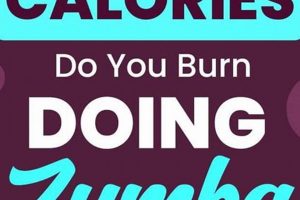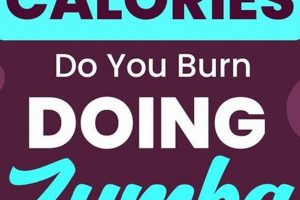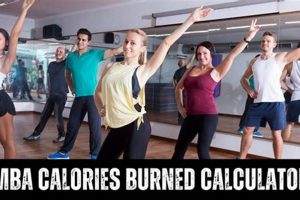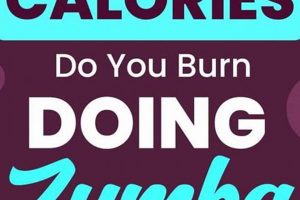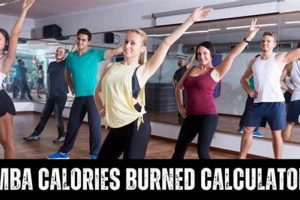The energy expenditure during a Zumba workout is a common point of inquiry. This is typically measured in calories, representing the amount of heat or energy the body uses to perform the activity. Factors influencing the caloric burn include individual weight, fitness level, intensity of the workout, and duration of the session. As an example, a person weighing 150 pounds might burn approximately 300-600 calories in a typical one-hour Zumba class.
Understanding the approximate energy expenditure is crucial for individuals aiming to manage weight, improve cardiovascular health, or simply maintain a balanced lifestyle. Zumba provides a fun and engaging way to incorporate exercise into a routine, offering a viable alternative to traditional workout formats. Its popularity has grown significantly since its inception in the late 1990s, driven by its accessible dance moves and effective fitness results.
The subsequent sections will delve deeper into the variables that affect the number of calories expended during this activity, providing a more nuanced understanding of its metabolic impact. These variables, including workout intensity and individual physiological factors, are essential for accurately estimating the benefits of incorporating the activity into a fitness regimen.
Maximizing Caloric Expenditure During Zumba
The following guidelines are designed to optimize caloric expenditure during Zumba workouts. These recommendations address various aspects of the activity, from intensity management to physiological considerations.
Tip 1: Maintain a Consistent Workout Intensity. Fluctuations in intensity can reduce the overall caloric burn. Strive for a consistent level of exertion throughout the duration of the activity.
Tip 2: Incorporate Full-Body Movements. Zumba routines that engage multiple muscle groups simultaneously will increase energy expenditure. Ensure that the routines selected actively involve both upper and lower body movements.
Tip 3: Increase Workout Duration Gradually. As fitness levels improve, progressively increase the duration of each session. Longer workouts will result in a higher overall caloric burn.
Tip 4: Engage Core Muscles. Actively engaging core muscles during Zumba movements not only enhances stability but also contributes to increased caloric expenditure. Focus on maintaining a tight core throughout the routine.
Tip 5: Consider Workout Timing. While individual preferences vary, some evidence suggests that exercising prior to consuming a meal may lead to a greater fat oxidation and, thus, a higher caloric burn. However, this strategy necessitates careful management of energy levels to prevent fatigue.
Tip 6: Monitor Heart Rate. Utilizing a heart rate monitor can provide valuable data regarding workout intensity. Aim to maintain a target heart rate within the aerobic zone to optimize fat burning.
Tip 7: Hydrate Adequately. Dehydration can impair performance and reduce metabolic efficiency. Ensure sufficient hydration prior to, during, and after the activity.
Adhering to these tips can effectively increase the energy expenditure during Zumba workouts, maximizing its fitness benefits. This optimization can contribute significantly to weight management and overall health improvement.
The subsequent section will explore common misconceptions regarding the activity and provide clarifications based on scientific evidence.
1. Intensity Level
The intensity level of a Zumba workout is a primary determinant of caloric expenditure. Variations in movement speed, range of motion, and the inclusion of high-impact elements directly influence the metabolic demands placed on the body, thereby affecting the total number of calories burned.
- Heart Rate Elevation
Higher intensity levels result in a greater elevation of heart rate. Sustained elevated heart rates, typically within the aerobic or anaerobic zones, correspond to increased energy utilization. For example, a Zumba class incorporating jumps, fast-paced routines, and powerful movements will drive heart rate higher, leading to a more significant caloric burn compared to a class emphasizing slower, more controlled steps.
- Oxygen Consumption
Intensity directly correlates with oxygen consumption. More intense movements necessitate a greater oxygen uptake to fuel muscle activity. This increased oxygen demand drives metabolic processes, resulting in a higher caloric expenditure. Workouts that incorporate interval training, alternating between high-intensity bursts and periods of lower activity, can maximize oxygen consumption and, consequently, caloric burn.
- Muscle Fiber Recruitment
The intensity of a Zumba class influences the number and type of muscle fibers recruited. High-intensity movements recruit a greater proportion of fast-twitch muscle fibers, which have a higher energy demand than slow-twitch fibers. Engaging a larger number of muscle fibers necessitates more energy, thus increasing caloric burn. Workouts designed to target multiple muscle groups simultaneously at a high intensity will amplify this effect.
- Post-Exercise Oxygen Consumption (EPOC)
High-intensity exercise, including Zumba, can lead to a greater post-exercise oxygen consumption (EPOC), also known as the “afterburn effect.” This refers to the elevated metabolic rate that persists after the workout has concluded. The body continues to consume oxygen at a higher rate to restore energy stores and repair muscle tissue, contributing to additional caloric expenditure even after the exercise session. Classes designed with varying intensity may increase EPOC.
The cumulative effect of these factors establishes a clear link between workout intensity and caloric expenditure during Zumba. By strategically manipulating the intensity level, participants can effectively manage and optimize the fitness benefits of the activity, particularly with regard to weight management and overall energy balance.
2. Workout Duration
Workout duration stands as a critical variable influencing total caloric expenditure during Zumba sessions. The longer an individual engages in the activity, the greater the opportunity for the body to expend energy and, consequently, burn calories.
- Linear Relationship with Caloric Burn
A direct relationship exists between the duration of a Zumba workout and the number of calories burned. Assuming a consistent intensity level, doubling the workout time will approximate a doubling of caloric expenditure. For instance, a 30-minute session may result in a burn of 300 calories, while extending the session to 60 minutes could lead to an expenditure of approximately 600 calories, contingent on maintaining the same intensity.
- Impact on Metabolic Rate
Extended workout durations contribute to an elevated metabolic rate both during and after the activity. Sustained physical exertion stimulates metabolic processes, increasing the rate at which the body burns calories. This effect is further amplified by the post-exercise oxygen consumption (EPOC), where the body continues to expend energy to recover and restore physiological balance. A longer duration translates into a longer period of elevated metabolism, contributing to an increased overall caloric burn.
- Influence on Cardiovascular Health
Prolonged Zumba sessions offer enhanced cardiovascular benefits, which indirectly contribute to caloric expenditure. Sustained aerobic activity strengthens the cardiovascular system, improving the body’s efficiency in delivering oxygen to working muscles. This enhanced efficiency allows for greater exertion over longer periods, further driving caloric burn. Individuals capable of maintaining longer workout durations typically exhibit improved cardiovascular fitness, enabling them to sustain higher intensity levels and expend more calories overall.
- Considerations for Fatigue and Injury Prevention
While longer workouts generally result in increased caloric expenditure, it is imperative to consider the potential for fatigue and injury. Overtraining can lead to decreased performance, increased risk of injury, and potentially, a reduction in metabolic efficiency. It is advisable to progressively increase workout duration to allow the body to adapt and avoid excessive strain. Furthermore, incorporating rest periods and proper hydration are crucial to maintaining performance and preventing adverse effects. A balanced approach ensures that workout duration maximizes caloric expenditure while minimizing the risk of negative consequences.
In summary, workout duration plays a significant role in determining the magnitude of caloric expenditure during Zumba. The linear relationship between time and caloric burn, the impact on metabolic rate, and the influence on cardiovascular health all contribute to the overall effect. However, responsible planning and considerations for fatigue and injury prevention are essential to optimize the benefits of prolonged Zumba sessions.
3. Individual weight
Individual weight is a primary determinant in the energy expenditure observed during Zumba sessions. The body mass being moved directly influences the caloric cost of any physical activity, including dance-based fitness programs.
- Increased Energy Demand
Individuals with higher body weights require more energy to perform the same movements as those with lower weights. The increased mass necessitates a greater force exertion from muscles, resulting in a proportionally higher caloric burn. For example, a person weighing 200 pounds will expend more energy performing a Zumba routine compared to a person weighing 150 pounds, even if both execute the movements with identical form and intensity.
- Impact on Metabolic Rate
While individual weight directly affects the caloric cost of specific movements, it is also intrinsically linked to basal metabolic rate (BMR). Individuals with greater body mass often possess higher BMRs, even at rest. This elevated resting metabolic rate contributes to a higher overall caloric expenditure throughout the day, including during exercise. However, it’s crucial to acknowledge that body composition (muscle vs. fat) significantly influences BMR beyond overall weight.
- Influence on Joint Stress
While increased weight leads to higher caloric expenditure, it also increases stress on joints. This factor can indirectly influence the sustainability and intensity of a Zumba workout. Individuals carrying excess weight may experience limitations in their range of motion or an increased risk of injury, potentially hindering their ability to maintain a high-intensity workout for an extended duration. Adaptation and modifications to the routine might be necessary to mitigate these risks.
- Effect on Exercise Intensity
A higher body weight can impact perceived exertion during Zumba. An individual may perceive a Zumba routine as being more strenuous compared to someone with a lower body weight. Even if both are performing the same activity, the added weight creates a greater physiological challenge, potentially leading to an earlier onset of fatigue. This subjective experience may influence the individual’s ability to maintain the exercise intensity, ultimately impacting caloric expenditure. It may be necessary to adjust intensity or incorporate breaks.
The relationship between individual weight and caloric expenditure during Zumba is multifaceted. While increased weight leads to greater energy demand and a higher potential caloric burn, it also introduces considerations regarding joint stress, perceived exertion, and exercise sustainability. Therefore, understanding the impact of individual weight is essential for customizing Zumba workouts to optimize fitness benefits while minimizing risks.
4. Metabolic Rate
Metabolic rate, the rate at which the body expends energy, fundamentally influences caloric expenditure during any physical activity, including Zumba. The basal metabolic rate (BMR), representing the energy required for basic physiological functions at rest, provides the foundation upon which activity-related caloric burn is added. Individuals with higher BMRs will inherently expend more calories during Zumba, even at similar intensity levels and durations, compared to those with lower BMRs. This is due to the increased energy demand required to support their larger or more metabolically active tissues. As an example, an individual with a higher muscle mass typically possesses a higher BMR, leading to increased energy expenditure throughout the day, inclusive of Zumba workouts. Therefore, the metabolic rate serves as an important baseline for evaluating potential caloric expenditure.
The thermic effect of activity (TEA), a component of the total metabolic rate, directly reflects the energy expended during physical exertion, such as Zumba. The intensity and duration of the Zumba workout dictate the magnitude of the TEA. High-intensity Zumba routines elevate metabolic rate significantly due to the increased demand for oxygen and energy to fuel muscle contractions. This elevation persists for a period after the workout, contributing to what is termed the “afterburn effect” or excess post-exercise oxygen consumption (EPOC). The magnitude of EPOC is influenced by both workout intensity and individual metabolic characteristics. Therefore, understanding both BMR and TEA allows a more complete picture of the overall impact of Zumba on metabolic function.
In conclusion, metabolic rate plays a critical role in determining the number of calories expended during Zumba. The interplay between basal metabolic rate, which establishes a baseline energy expenditure, and the thermic effect of activity, which reflects the energy cost of the workout itself, shapes the overall caloric burn. Factors influencing metabolic rate, such as muscle mass, age, and genetics, contribute to individual variations in energy expenditure. Accurately accounting for these factors enhances the ability to estimate and manage the potential benefits of Zumba for weight management and overall health improvement. A challenge remains in precisely quantifying metabolic rate in a non-clinical setting, yet understanding its influence remains vital.
5. Muscle Mass
Muscle mass exerts a significant influence on caloric expenditure during Zumba workouts. Muscle tissue is metabolically active, requiring more energy to maintain compared to fat tissue. Consequently, individuals with a greater proportion of muscle mass exhibit a higher resting metabolic rate (RMR), the number of calories burned at rest. This elevated baseline metabolism translates to a greater overall caloric expenditure during physical activities such as Zumba. For instance, an individual with a higher muscle mass will burn more calories during the same Zumba class as someone with lower muscle mass, even if they weigh the same and perform the routine with equal intensity.
The relationship between muscle mass and caloric expenditure extends beyond RMR. During a Zumba workout, muscle tissue requires energy to contract and facilitate movement. Individuals with more muscle mass are capable of generating greater force and sustaining higher intensity levels, leading to an increased demand for energy and, therefore, a greater caloric burn. The engagement of multiple muscle groups simultaneously during Zumba further amplifies this effect. Moreover, resistance training, which promotes muscle growth, complements Zumba by further elevating RMR and enhancing overall fitness. Example, regular weight training may increase muscle mass and that may lead to significant calorie burn.
In summary, muscle mass plays a crucial role in determining the energy expenditure during Zumba workouts. Its contribution extends from increasing the basal metabolic rate to facilitating higher intensity levels and greater force production. Understanding this connection underscores the importance of incorporating strategies to build and maintain muscle mass as part of a comprehensive fitness plan aimed at maximizing the benefits of Zumba, including effective weight management and improved overall health. Building of Muscle mass is essential when people doing Zumba.
6. Workout Type
The specific structure and elements of a Zumba class, classified as “workout type,” profoundly influence the total caloric expenditure. Variations in dance styles, intensity levels, and incorporated fitness elements directly impact the metabolic demands placed on participants, consequently affecting the number of calories burned.
- Interval-Based Routines
Zumba classes incorporating interval training, alternating between high-intensity dance sequences and periods of lower-intensity recovery, tend to yield higher caloric burns. The bursts of intense activity elevate heart rate and metabolic rate, while the recovery periods allow for partial recovery before the next burst. This cyclical pattern maximizes oxygen consumption and promotes the “afterburn effect,” leading to increased energy expenditure even after the workout concludes. For example, a Zumba class featuring rapid transitions between salsa and reggaeton, with short rests in between, utilizes interval training effectively.
- Endurance-Focused Sessions
Zumba workouts prioritizing sustained, moderate-intensity activity for extended durations emphasize cardiovascular endurance and promote fat oxidation. These sessions maintain a consistent heart rate within the aerobic zone, encouraging the body to utilize fat as a primary fuel source. This type of Zumba class, often incorporating longer, uninterrupted dance sequences, is beneficial for individuals seeking to improve cardiovascular fitness and burn a significant number of calories through prolonged, moderate exertion. A Zumba class focused on cumbia and merengue styles, maintained at a steady pace, exemplifies an endurance-focused workout.
- Strength-Oriented Integrations
Some Zumba classes incorporate resistance training elements, such as squats, lunges, and push-ups, strategically integrated within the dance routines. These additions increase muscle engagement and demand more energy, resulting in a higher caloric burn compared to classes solely focused on dance steps. The integration of strength-building exercises not only enhances caloric expenditure but also contributes to improved muscle tone and overall fitness. A Zumba Toning class, utilizing light weights during specific routines, is an example.
- Themed Zumba Variations
Specialized Zumba formats, such as Zumba Step (incorporating step aerobics) or Aqua Zumba (conducted in a pool), introduce unique challenges that influence caloric expenditure. Zumba Step increases the intensity of lower body movements, resulting in a higher caloric burn. Aqua Zumba utilizes water resistance, further increasing energy expenditure. The caloric burn observed varies depending on the specific theme, intensity, and duration.
The selected workout type directly influences the metabolic demands of a Zumba session, and the caloric expenditure that results. Interval-based, endurance-focused, strength-oriented, and themed variations each offer unique approaches to fitness, and their effects on the “how many calories burn in zumba” depend upon the specific factors. Careful consideration of one’s fitness goals and preferences can lead to selection of specific styles that optimizes energy expenditure.
7. Food intake
Food intake, representing the energy consumed through diet, fundamentally interacts with the energy expenditure during Zumba sessions. The balance between caloric consumption and expenditure dictates weight management outcomes and influences the body’s ability to perform and recover from physical activity. Understanding this relationship is essential for optimizing the benefits of Zumba in achieving fitness goals.
- Pre-Workout Nutrition
The composition and timing of food intake prior to a Zumba workout influence energy availability and performance. Consuming a balanced meal or snack containing carbohydrates and protein 1-3 hours before exercising provides the body with the necessary fuel to sustain intensity and duration. For example, a small serving of whole-grain toast with peanut butter can provide sustained energy release, while a protein shake supports muscle function. Insufficient pre-workout nutrition may lead to fatigue and reduced caloric expenditure during the session. It is recommended that the nutrient content and the timing should be monitored for any changes that can affect the workout output.
- Intra-Workout Nutrition
During extended Zumba sessions, particularly those exceeding one hour, maintaining hydration and electrolyte balance through appropriate fluid intake is critical. Water is essential for facilitating metabolic processes and regulating body temperature. Electrolyte-containing beverages can replenish minerals lost through sweat, preventing muscle cramps and maintaining performance. For example, consuming sports drinks, or water with electrolyte tablets can aid in preserving workout quality, preventing output declines and increased burn.
- Post-Workout Recovery
Replenishing glycogen stores and supporting muscle repair following a Zumba workout necessitates consuming adequate carbohydrates and protein. Carbohydrates restore energy reserves depleted during exercise, while protein aids in muscle protein synthesis and recovery. For instance, a post-workout meal consisting of lean protein (chicken or fish) and complex carbohydrates (brown rice or quinoa) promotes optimal recovery and muscle growth. This recovery fuels the process of building, strengthening, and burning more calories in future activities.
- Overall Caloric Balance
Achieving a negative caloric balance, where energy expenditure exceeds energy intake, is essential for weight loss. While Zumba contributes to caloric expenditure, it is crucial to manage overall food intake to create a deficit. Consuming a nutrient-rich diet while maintaining a moderate caloric restriction promotes fat loss while preserving muscle mass. For example, replacing processed foods with whole, unprocessed options and controlling portion sizes can facilitate weight management alongside regular Zumba sessions. Creating this deficit encourages further caloric burn through increased effort by drawing from stored reserves and pushing the body further.
In conclusion, food intake exerts a profound influence on the energy expenditure and overall effectiveness of Zumba workouts. From pre-workout fueling to post-workout recovery and overall caloric balance, managing dietary intake strategically optimizes performance, promotes recovery, and supports weight management goals. Calorie burn must be coupled with a nutritious dietary consumption to achieve optimal levels.
Frequently Asked Questions
The following section addresses common inquiries regarding the energy expenditure associated with Zumba workouts. These questions aim to clarify prevailing uncertainties and provide evidence-based information.
Question 1: Does Zumba intensity affect caloric expenditure?
Yes, higher intensity Zumba classes yield greater caloric expenditure. Increased movement speed, range of motion, and integration of high-impact elements drive up metabolic demands.
Question 2: How does individual weight impact caloric burn in Zumba?
Individuals with higher body weights expend more calories performing the same Zumba routines compared to those with lower weights, owing to the increased energy demand for movement.
Question 3: Does muscle mass play a role in caloric burn during Zumba?
Increased muscle mass elevates basal metabolic rate, leading to higher overall caloric expenditure during Zumba sessions, even at comparable intensity levels.
Question 4: How does workout duration impact total caloric burn during Zumba?
The relationship between workout duration and caloric expenditure is generally linear. Extending the duration of a Zumba session will result in a greater total caloric burn, assuming intensity is maintained.
Question 5: Are there specific Zumba workout types that burn more calories?
Zumba classes incorporating interval training, or strategically integrated resistance training exercises will often results in higher caloric expenditure.
Question 6: How does food intake impact caloric burn and weight management during Zumba?
Strategic food intake optimizes performance, promotes recovery, and supports weight management goals. Pre-workout nutrition sustains intensity, while post-workout meals replenish glycogen stores and support muscle repair.
In summary, diverse factors, including intensity, weight, muscle mass, duration, workout type, and diet, influence caloric expenditure during Zumba. A holistic understanding of these variables can optimize the effectiveness of Zumba for weight management and improved health.
The subsequent section presents practical strategies for maximizing the effectiveness of Zumba.
Conclusion
The preceding analysis has elucidated the multifaceted factors influencing energy expenditure during Zumba workouts. The phrase “how many calories burn in Zumba” encapsulates a complex interaction between individual physiology, workout parameters, and dietary considerations. Understanding these elementsintensity, duration, muscle mass, body weight, metabolic rate, workout type, and food intakepermits a more accurate estimation of caloric expenditure and facilitates personalized optimization strategies.
Continued research and refined measurement techniques may further enhance the precision with which energy expenditure during this exercise modality can be quantified. However, the current evidence provides a solid foundation for informed decision-making. The efficacy of Zumba as a fitness tool is undeniable; its potential is maximized through application of the principles outlined herein. Individuals are encouraged to use this knowledge to achieve their specific fitness goals through informed customization of their Zumba routines.


